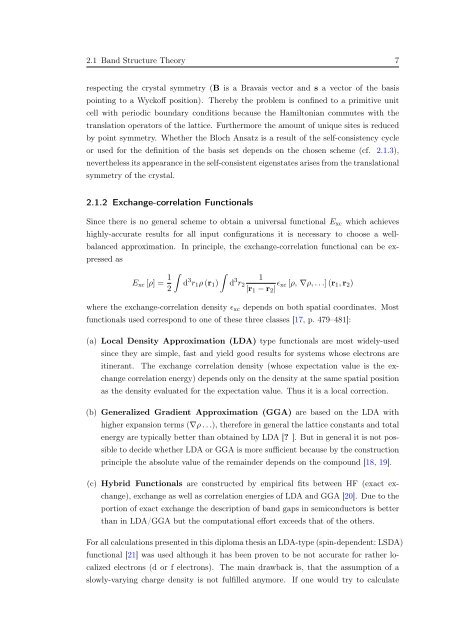Diploma - Max Planck Institute for Solid State Research
Diploma - Max Planck Institute for Solid State Research
Diploma - Max Planck Institute for Solid State Research
Create successful ePaper yourself
Turn your PDF publications into a flip-book with our unique Google optimized e-Paper software.
2.1 Band Structure Theory 7<br />
respecting the crystal symmetry (B is a Bravais vector and s a vector of the basis<br />
pointing to a Wyckoff position). Thereby the problem is confined to a primitive unit<br />
cell with periodic boundary conditions because the Hamiltonian commutes with the<br />
translation operators of the lattice. Furthermore the amount of unique sites is reduced<br />
by point symmetry. Whether the Bloch Ansatz is a result of the self-consistency cycle<br />
or used <strong>for</strong> the definition of the basis set depends on the chosen scheme (cf. 2.1.3),<br />
nevertheless its appearance in the self-consistent eigenstates arises from the translational<br />
symmetry of the crystal.<br />
2.1.2 Exchange-correlation Functionals<br />
Since there is no general scheme to obtain a universal functional E xc which achieves<br />
highly-accurate results <strong>for</strong> all input configurations it is necessary to choose a wellbalanced<br />
approximation. In principle, the exchange-correlation functional can be expressed<br />
as<br />
E xc [ρ] = 1 2<br />
∫<br />
∫<br />
d 3 r 1 ρ (r 1 )<br />
d 3 r 2<br />
1<br />
|r 1 − r 2 | ɛ xc [ρ, ∇ρ, . . .] (r 1 , r 2 )<br />
where the exchange-correlation density ɛ xc depends on both spatial coordinates. Most<br />
functionals used correspond to one of these three classes [17, p. 479–481]:<br />
(a) Local Density Approximation (LDA) type functionals are most widely-used<br />
since they are simple, fast and yield good results <strong>for</strong> systems whose electrons are<br />
itinerant.<br />
The exchange correlation density (whose expectation value is the exchange<br />
correlation energy) depends only on the density at the same spatial position<br />
as the density evaluated <strong>for</strong> the expectation value. Thus it is a local correction.<br />
(b) Generalized Gradient Approximation (GGA) are based on the LDA with<br />
higher expansion terms (∇ρ . . .), there<strong>for</strong>e in general the lattice constants and total<br />
energy are typically better than obtained by LDA [? ]. But in general it is not possible<br />
to decide whether LDA or GGA is more sufficient because by the construction<br />
principle the absolute value of the remainder depends on the compound [18, 19].<br />
(c) Hybrid Functionals are constructed by empirical fits between HF (exact exchange),<br />
exchange as well as correlation energies of LDA and GGA [20]. Due to the<br />
portion of exact exchange the description of band gaps in semiconductors is better<br />
than in LDA/GGA but the computational ef<strong>for</strong>t exceeds that of the others.<br />
For all calculations presented in this diploma thesis an LDA-type (spin-dependent: LSDA)<br />
functional [21] was used although it has been proven to be not accurate <strong>for</strong> rather localized<br />
electrons (d or f electrons). The main drawback is, that the assumption of a<br />
slowly-varying charge density is not fulfilled anymore.<br />
If one would try to calculate
















